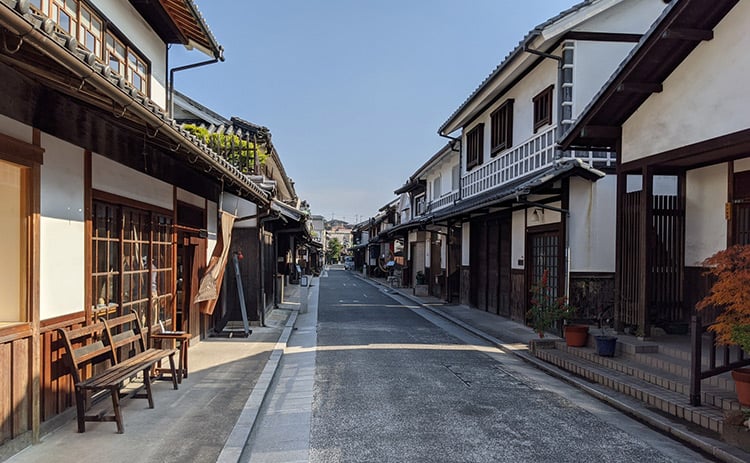Okayama: Birthplace of the Momotaro Legend
Okayama is located in the Chugoku region of western Honshu. The prefecture is bordered by the Seto Inland Sea to the south and the San-in region to the north; it is also known as the gateway to the Great Seto Bridge that connects Honshu to Shikoku. Three Class-A rivers—the Yoshii, the Takahashi, and the Asahi—flow through the prefecture, which is rich in bountiful nature and beautiful scenery, blessed by the sea, the mountains, and the rivers. Its many sightseeing destinations include Okayama Castle with its distinctive black exterior, the Okayama Koraku-en garden that is one of the three most famous gardens in Japan, and the Kurashiki Bikan Historical Quarter, renowned for its beautiful white walls. You can also learn about the rich history and traditions, including the Saidaiji Eyo Festival (nicknamed “Hadaka Matsuri” or “Naked Festival”), known as one of Japan’s three strangest festivals.
This land, which was once known as “Kibi,” is said in legend to have been the site of the defeat of the demon Ura by Kibi-tsu-hiko (“Prince of Kibi”). “Oni-no-shiro” (“Demon’s Castle”), the ancient mountain fortress that Ura called home, and the giant rocks, “Tatetsuki-iseki,” which put one in mind of the enormous shields used in the battle against Ura, are among the historic sites associated with the legend. There are those who say that this legend formed the basis for the “Momotaro” folktale that is known to everyone in Japan. Kibitsu Shrine, which is dedicated to Kibi-tsu-hiko, and a number of other cultural properties comprise the Japan Heritage site “Okayama, the Birthplace of the Legend of Momotaro,” formally recognized in 2018 by the national Agency for Cultural Affairs.
Okayama, which has few rainy days throughout the year and a warm Setouchi climate, is known as “the Sunshine Prefecture.” With its abundant nature, it will allow you to enjoy delicious food whatever the season. It is also known as “the Kingdom of Fruit,” being a well-known producer of fruits such as white peaches, Muscat grapes, and Pione grapes. The Spanish mackerel, a herald of spring, is also a representative specialty of Okayama. Because this fish goes bad very quickly, in other parts of the country it is usually eaten marinated in miso or grilled with salt; but in Okayama, it is often eaten raw, which is proof of its freshness. There is also “Mamakari,” which is a famous local specialty of the region. There are various different theories about the origin of this name, one being that the baby fish of the herring family, called “sappa” in standard Tokyo Japanese, was so delicious that you would want to “borrow” (kari) some extra “rice” (mama) from someone to go with it. Another theory is that, as it is in season when rice is harvested, it comes from “cutting (karu) rice stalks (mama).”
Read more
Hide
Okayama is located in the Chugoku region of western Honshu. The prefecture is bordered by the Seto Inland Sea to the south and the San-in region to the north; it is also known as the gateway to the Great Seto Bridge that connects Honshu to Shikoku. Three Class-A rivers—the Yoshii, the Takahashi, and the Asahi—flow through the prefecture, which is rich in bountiful nature and beautiful scenery, blessed by the sea, the mountains, and the rivers. Its many sightseeing destinations include Okayama Castle with its distinctive black exterior, the Okayama Koraku-en garden that is one of the three most famous gardens in Japan, and the Kurashiki Bikan Historical Quarter, renowned for its beautiful white walls. You can also learn about the rich history and traditions, including the Saidaiji Eyo Festival (nicknamed “Hadaka Matsuri” or “Naked Festival”), known as one of Japan’s three strangest festivals.
This land, which was once known as “Kibi,” is said in legend to have been the site of the defeat of the demon Ura by Kibi-tsu-hiko (“Prince of Kibi”). “Oni-no-shiro” (“Demon’s Castle”), the ancient mountain fortress that Ura called home, and the giant rocks, “Tatetsuki-iseki,” which put one in mind of the enormous shields used in the battle against Ura, are among the historic sites associated with the legend. There are those who say that this legend formed the basis for the “Momotaro” folktale that is known to everyone in Japan. Kibitsu Shrine, which is dedicated to Kibi-tsu-hiko, and a number of other cultural properties comprise the Japan Heritage site “Okayama, the Birthplace of the Legend of Momotaro,” formally recognized in 2018 by the national Agency for Cultural Affairs.
Okayama, which has few rainy days throughout the year and a warm Setouchi climate, is known as “the Sunshine Prefecture.” With its abundant nature, it will allow you to enjoy delicious food whatever the season. It is also known as “the Kingdom of Fruit,” being a well-known producer of fruits such as white peaches, Muscat grapes, and Pione grapes. The Spanish mackerel, a herald of spring, is also a representative specialty of Okayama. Because this fish goes bad very quickly, in other parts of the country it is usually eaten marinated in miso or grilled with salt; but in Okayama, it is often eaten raw, which is proof of its freshness. There is also “Mamakari,” which is a famous local specialty of the region. There are various different theories about the origin of this name, one being that the baby fish of the herring family, called “sappa” in standard Tokyo Japanese, was so delicious that you would want to “borrow” (kari) some extra “rice” (mama) from someone to go with it. Another theory is that, as it is in season when rice is harvested, it comes from “cutting (karu) rice stalks (mama).”









